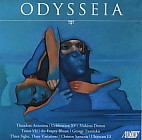Recordings

| NEW MUSIC FROM GREEK AND GREEK-AMERICAN COMPOSERS. ANTONIOU | DEMOS | TSONTAKIS | SAMARAS Odysseia TROY1413 - $16.99 / ALBANY RECORDS |
| Read More |

- Nevart-Veron Galileas, flute/alto flute
- Theofilos Sotiriadis, alto saxophone
- Christos Galileas, violin
- Brandt Fredriksen, piano
Theodore Antoniou (born 1935) Celebration XV
Celebration XV (2009) is a quartet written for a rather unusual instrumental ensemble (flute/alto flute, alto saxophone, violin and piano). The piece has three distinct sections. Like most of Antoniou’s works it has a virtuoso character and at the same time makes use of some idiomatic instrumental techniques. The piece was dedicated to the neoPhonia New Music Ensemble and was premiered on March 16, 2010 in Atlanta, GA.
Recorded Live at the International Chamber Music Festival (T.C.H.O) May 29, 2013
Nevart-Veron Galileas, flute, Timothy Hester, Piano
Albert Roussel (1869-1937), Monsieur de la Pejaudie from Joueurs de flute op. 27- no. 4
Lili Boulanger (1893-1918), Nocturne
- Nevart-Veron Galileas, flute
- Nikos Kiriosoglou, piano
Cesar Franck (1822-1890) Sonata in A major
Cesar Franck’ s Sonata in A major was a wedding gift for his friend Eugene Ysaye, the renowned Belgium violinist. It is considered one of his finest compositions. Franck recognized the validity of performing the violin sonata on the flute so he published a flute version of the sonata. The transformation, which required only minimal alterations to fall within the flute’ s register, submit perfectly to its color and temperament establishing its importance within the flute repertoire.
Recorded Live at the International Festival of Nafplion June 28, 2009
- Nevart-Veron Galileas, flute
- Nikos Kiriosoglou, piano
Bohuslav Martinu (1890-1959) First Sonata for Flute and Piano
Bohuslav Martinu composed his sonata for flute and piano in 1945 in Cape Cod, Massachusetts. It was dedicated to the flutist George Laurent who was at the time the principal of the Boston Symphony Orchestra. The sonata has a noble character drawing on Czech, French and American traditions. It makes use of counterpoint, driving rhythms and irregular measures, all characteristics of Martinu’s style.